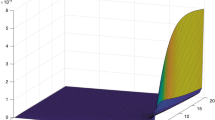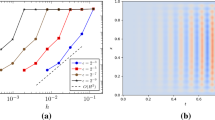Abstract
The paper develops the essentially optimal sparse tensor product finite element method for a parabolic equation in a domain in \(\mathbb {R}^{d}\) which depends on a microscopic scale in space and a microscopic scale in time. We consider the critical self similar case which has the most interesting homogenization limit. We solve the high dimensional time-space multiscale homogenized equation, which provides the solution to the homogenized equation which describes the multiscale equation macroscopically, and the corrector which encodes the microscopic information. For obtaining an approximation within a prescribed accuracy, the method requires an essentially optimal number of degrees of freedom that is essentially equal to that for solving a macroscopic parabolic equation in a domain in \(\mathbb {R}^{d}\). A numerical corrector is deduced from the finite element solution. Numerical examples for one and two dimensional problems confirm the theoretical results. Although the theory is developed for problems with one spatial microscopic scale, we show numerically that the method is capable of solving problems with more than one spatial microscopic scale.
Similar content being viewed by others
References
Abdulle, A., E, W., Engquist, B., Vanden-Eijnden, E.: The heterogeneous multiscale method. Acta Numer. 21, 1–87 (2012)
Abdulle, A., Huber, M.E.: Finite element heterogeneous multiscale method for nonlinear monotone parabolic homogenization problems. ESAIM Math. Model. Numer Anal. 50(6), 1659–1697 (2016)
Abdulle, A., Vilmart, G.: Coupling heterogeneous multiscale FEM with Runge-Kutta methods for parabolic homogenization problems: a fully discrete spacetime analysis. Math. Models Methods Appl. Sci. 22(6), 1250002 (2012)
Allaire, G.: Homogenization and two-scale convergence. SIAM J. Math. Anal. 23(6), 1482–1518 (1992)
Bensoussan, A., Lions, J.-L., Papanicolaou, G.: Asymptotic analysis for periodic structures, volume 5 of studies in mathematics and its applications. North-Holland Publishing Co., Amsterdam (1978)
Bieri, M., Andreev, R., Schwab, C.: Sparse tensor discretization of elliptic SPDEs. SIAM J. Sci. Comput. 31(6), 4281–4304 (2009/10)
Bungartz, H.-J., Griebel, M.: Sparse grids. Acta Numer. 13, 147–269 (2004)
Chen, S., E, W., Shu, C.-W.: The heterogeneous multiscale method based on the discontinuous Galerkin method for hyperbolic and parabolic problems. Multiscale Model Simul. 3(4), 871–894 (2005)
Chu, V.T., Hoang, V.H.: High dimensional finite elements for multiscale Maxwell-type equations. IMA J. Numer. Anal. 38(1), 227–270 (2018)
Chung, E.T., Efendiev, Y., Leung, W.T., Ye, S.: Generalized multiscale finite element methods for space-time heterogeneous parabolic equations. Comput. Math Appl. 76(2), 419–437 (2018)
Cioranescu, D., Damlamian, A., Griso, G.: The periodic unfolding method in homogenization. SIAM J. Math. Anal. 40(4), 1585–1620 (2008)
Douglas, J. Jr., Dupont, T.: Galerkin methods for parabolic equations. SIAM J. Numer. Anal. 7, 575–626 (1970)
Efendiev, Y., Hou, T.Y.: Multiscale finite element methods: theory and applications. surveys and tutorials in the applied mathematical sciences. Springer (2009)
Efendiev, Y., Pankov, A.: Numerical homogenization of nonlinear random parabolic operators. Multiscale Model Simul. 2(2), 237–268 (2004)
Efendiev, Y., Galvis, J., Hou, T.Y.: Generalized multiscale finite element methods (GMsFEM). J. Comput. Phys. 251, 116–135 (2013)
Evans, L.C.: Partial differential equations, volume 19 of Graduate Studies in Mathematics. American Mathematical Society, Providence (1998)
Geng, J., Shen, Z.: Convergence rates in parabolic homogenization with time-dependent periodic coefficients. J. Funct Anal. 272(5), 2092–2113 (2017)
Griebel, M., Oswald, P.: Tensor product type subspace splittings and multilevel iterative methods for anisotropic problems. Adv. Comput. Math. 4(1), 171–206 (1995)
Grisvard, P.: Elliptic problems in nonsmooth domains, volume 69 of Classics in Applied Mathematics. Society for Industrial and Applied Mathematics (SIAM), Philadelphia (2011)
Hoang, V.H., Schwab, C.: High-dimensional finite elements for elliptic problems with multiple scales. Multiscale Model. Simul. 3(1), 168–194 (2004/05)
Holmbom, A., Svanstedt, N., Wellander, N.: Multiscale convergence and reiterated homogenization of parabolic problems. Appl. Math. 50(2), 131–151 (2005)
Hou, T.Y., Wu, X.H.: A multiscale finite element method for elliptic problems in composite materials and porous media. J. Comput. Phys. 134(1), 169–189 (1997)
Kazeev, V., Oseledets, I., Rakhuba, M., Schwab, C.: QTT-finite-element approximation for multiscale problems I: model problems in one dimension. Adv. Comput. Math. 43(2), 411–442 (2017)
Lions, J.L., Magenes, E.: Non-homogeneous boundary value problems and applications, vol. I. Springer, Berlin (1972)
Målqvist, A., Persson, A.: Multiscale techniques for parabolic equations. Numer. Math. 138(1), 191–217 (2018)
Målqvist, A., Peterseim, D.: Localization of elliptic multiscale problems. Math. Comp. 83(290), 2583–2603 (2014)
Ming, P., Zhang, P.: Analysis of the heterogeneous multiscale method for parabolic homogenization problems. Math Comp. 76(257), 153–177 (2007)
Nguetseng, G.: A general convergence result for a functional related to the theory of homogenization. SIAM J. Math. Anal. 20(3), 608–623 (1989)
Owhadi, H., Zhang, L.: Homogenization of parabolic equations with a continuum of space and time scales. SIAM J. Numer. Anal. 46(1), 1–36 (2008)
Tan, W.C., Hoang, V.H.: High dimensional finite element method for multiscale nonlinear monotone parabolic equations. J. Comput. Appl. Math. 345, 471–500 (2019)
Wloka, J.: Partial differential equations. Cambridge University Press, Cambridge (1987)
Woukeng, J.L.: Periodic homogenization of nonlinear non-monotone parabolic operators with three time scales. Ann. Mat. Pura Appl. (4) 189(3), 357–379 (2010)
Xia, B., Hoang, V.H.: High dimensional finite elements for multiscale wave equations. Multiscale Model. Simul. 12(4), 1622–1666 (2014)
Xia, B., Hoang, V.H.: High-dimensional finite element method for multiscale linear elasticity. IMA J. Numer. Anal. 35(3), 1277–1314 (2015)
Xia, B., Hoang, V.H.: Sparse tensor finite elements for elastic wave equation with multiple scales. J. Comput. Appl. Math. 282, 179–214 (2015)
Acknowledgments
The research topic originates from a discussion with Professor Christoph Schwab, ETH, Zurich. The authors gratefully acknowledge a postgraduate scholarship of A*Star, Singapore, the AcRF Tier 1 grant 2016-T1-001-202 RG30/16, the Singapore A*Star SERC grant 122-PSF-0007, and the AcRF Tier 2 grant MOE 2013-T2-1-095 ARC 44/13.
Author information
Authors and Affiliations
Corresponding author
Additional information
Communicated by: Ivan Oseledets
Publisher’s note
Springer Nature remains neutral with regard to jurisdictional claims in published maps and institutional affiliations.
Appendix
Appendix
We prove Theorem 3.2 in this appendix. Let \(\rho _{0,m}={1\over {\Delta } t}(u_{0}(t_{m + 1})-u_{0}(t_{m}))-{\partial u_{0}\over \partial t}(t_{m + 1/2})\), \(\zeta _{0,m}=\frac 12(u_{0}(t_{m + 1})+u_{0}(t_{m}))-u_{0}(t_{m + 1/2})\), \(\zeta _{1,m}=\frac 12(u_{1}(t_{m + 1})+u_{1}(t_{m}))-u_{1}(t_{m + 1/2})\) and \(\xi _{1,m}={1\over 2}\left ({\partial u_{1}\over \partial \tau }(t_{m + 1})+{\partial u_{1}\over \partial \tau }(t_{m})\right )-{\partial u_{1}\over \partial \tau }(t_{m + 1/2})\). Since u0 ∈ C3([0, T], H) ∩ C2([0, T], V ), u1 ∈ C2([0, T], L2(D × (0, 1), V#)) and \({\partial u_{1}\over \partial \tau }\in C^{2}([0,T],L^{2}(D\times (0,1),V^{\prime }_\#))\), we deduce that
where the constant c does not depend on m. From (2.1) and (3.1) considered at t = tm+ 1/2 we deduce that
Consider
For \(\{\tilde u_{0,m},\ m = 0,\ldots ,M\}\subset V^{L}\) and \(\{\tilde u_{1,m},\ m = 1,\ldots ,M\}\subset {V_{1}^{L}}\), we have
From (3.1) we have
We note that \((\tilde u_{0}-U_{0})_{m + 1/2}=(\tilde u_{0}-u_{0})_{m + 1/2}+z_{0,m + 1/2}\) and \((\tilde u_{1}-U_{1})_{m + 1/2}=(\tilde u_{1}-u_{1})_{m + 1/2}+z_{1,m + 1/2}\). For a positive constant δ > 0, using the Cauchy-Schwartz inequality, we have
From this and (A.2), choosing δ sufficiently small, we have
Fixing an integer P ≤ M, taking the sum for m = 0, … , P − 1, we have
We note that
which is a consequence of the Cauchy-Schwartz inequality; δ is an arbitrary positive constant. We note that \({\Delta } t{\sum }_{m = 1}^{P-1}\|z_{0,m}\|_{H}^{2}\le {\Delta } t P\max _{m = 0,\ldots ,M}\|z_{0,m}\|_{H}^{2}\le T\max _{m = 0,\ldots ,M}\|z_{0,m}\|_{H}^{2}\). From this and (A.3), choosing δ sufficiently small, we have
Choosing δ sufficiently small, we have
From this, we get the conclusion.
Rights and permissions
About this article
Cite this article
Tan, W.C., Hoang, V.H. High dimensional finite elements for time-space multiscale parabolic equations. Adv Comput Math 45, 1291–1327 (2019). https://doi.org/10.1007/s10444-018-09657-7
Received:
Accepted:
Published:
Issue Date:
DOI: https://doi.org/10.1007/s10444-018-09657-7
Keywords
- High dimensional finite elements
- Time-space multiscale parabolic equations
- Optimal complexity
- Numerical corrector




